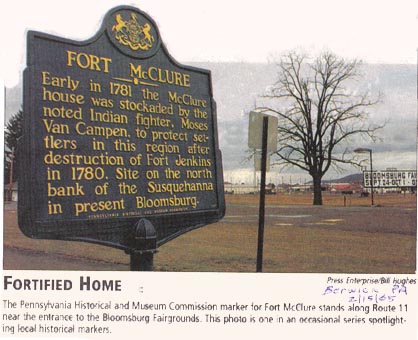We don't know that this distinguished pioneer Indian fighter ever visited Letchworth Park but visitors who enjoy the Museum will recall seeing Moses' portrait on display.
His connection to the park is by way of the Council House located on the Council Grounds where Mr. Letchworth chose to display the remnants of the Native American presence in the Genesee River valley that he preserved -- the Mary Jemison statue and grave, the Nancy Jemison cabin and the Council house that he purchased and had delivered to the Glen Iris Estate while he still lived there.
Van Campen
arises in the history annals in Columbia County, Pennsylvania
about 1773 when his parents brought him to that area where they
settled along Cabin Run. He became a soldier and served under
Washington. By 1778 he was a Lieutenant serving frontier duty
when ordered to construct a fort on Fishing Creek about 3 miles
above its mouth to protect the  settlements
in that area. This Fort was attacked twice. The Indians burned
the houses and buildings in the area but settlers made it to the
fort. Van Campen's family lost their home in that attack. Some
time later the family attempted to return to their home site and
were surprised by a raiding party and Van Campen's father and
brother were killed. Moses was captured. Eventually he was with
other captives being moved north when he convinced his fellow
captors to escape. Using a knife that one of the Indians had lost
they cut themselves free and attacked the sleeping captors killing
nine of the ten. The tenth was wounded by Van Campen but managed
to escape. This escapade occurred near the mouth of Tunkhannock
Creek.
settlements
in that area. This Fort was attacked twice. The Indians burned
the houses and buildings in the area but settlers made it to the
fort. Van Campen's family lost their home in that attack. Some
time later the family attempted to return to their home site and
were surprised by a raiding party and Van Campen's father and
brother were killed. Moses was captured. Eventually he was with
other captives being moved north when he convinced his fellow
captors to escape. Using a knife that one of the Indians had lost
they cut themselves free and attacked the sleeping captors killing
nine of the ten. The tenth was wounded by Van Campen but managed
to escape. This escapade occurred near the mouth of Tunkhannock
Creek.
Eventually he was captured again and was taken as far as Caneadea NY where the Council House of Letchworth Park originally stood. There Van Campen was forced to run the gauntlet. He managed to accomplish this tortuous run and again escaped. Thus he is one of the legends of Letchworth park Native American lore.
The Berwick Pennsylvania chapter of the Daughters of the American Revolution is named the Van Campen Chapter in honor of his service on the frontier along the Susquehanna river.
Van Campen returned to the Genesee Valley in the 1790's as a pioneer and a surveyor. He laid out much of the 100,000 acre "Church Tract" belonging to Judge Philip Church and laid out the important turnpike between Bath and Olean. He eventually moved to Dansville, Livingston County, in 1831, but returned to his homestead in Angelica just before his death on October 15, 1849.
Moses Van Campen rests from his long and adventurous life in the cemetery in the charming village of Angelica, but will for ever be associated with Letchworth Park.
Tom Breslin
Sources:
Barton, Edwin M. History of Columbia County, Sponsored by the Columbia County Historical Society and the Commissioners of Columbia County. 1958
Hubbard, J. Niles. Sketches of Border Adventures in the Life and times of Major Moses Van Campen. Fillmore NY: Jno. S. Minard, publisher, 1893.
Also see: Busch, Clarence M. REPORT OF THE COMMISSION TO LOCATE THE SITES OF THE FRONTIER FORTS OF PENNSYLVANIA.Volume One. State Printer of Pennsylvania. 1896.
Additional information about Moses VanCampen's career and that of his cousin Daniel is available from the Berwick Historical Society, P O Box 301, Berwick, PA 18603